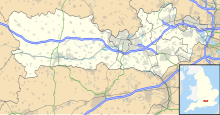| Site of Special Scientific Interest | |
 | |
 | |
| Location | Berkshire |
|---|---|
| Grid reference | SU 843 628 |
| Coordinates | 51°21′25″N 0°47′20″W / 51.357°N 0.789°W / 51.357; -0.789 |
| Interest | Biological |
| Area | 85.8 hectares (212 acres) |
| Notification | 1983 |
| Location map | Magic Map |
Sandhurst to Owlsmoor Bogs and Heaths is an 85.8-hectare (212-acre) biological Site of Special Scientific Interest (SSSI) on the northern outskirts of Sandhurst in Berkshire. Part of the SSSI is Wildmoor Heath nature reserve, which is managed by the Berkshire, Buckinghamshire and Oxfordshire Wildlife Trust. and the SSSI is part of Thames Basin Heaths Special Protection Area.
Geography
Wildmoor Heath is situated on a slope and features wet and dry lowland heath and valley bog, plus pine and broadleaved woodland.
History
In 1975 the site was designated a site of special scientific interest (SSSI). Wildmoor Heath nature reserve was formed in 1998 by combining land at Edgbarrow Woods, Owlsmoor Bog, and Wildmoor Bottom.
Fauna
The site has the following animals:
Mammals
Reptiles and amphibians
Birds
- Common chiffchaff
- Great spotted woodpecker
- European green woodpecker
- European nightjar
- Common snipe
- European stonechat
- Willow warbler
- Dartford warbler
- Woodlark
- Eurasian bullfinch
- Eurasian hobby
- Common kingfisher
Invertebrates
- Hairy dragonfly
- Common hawker
- Golden-ringed dragonfly
- Libellula depressa
- Keeled skimmer
- Beautiful demoiselle
- Banded demoiselle
- Lestes sponsa
- Erythromma najas
- Large red damselfly
- Blue-tailed damselfly
- Enallagma cyathigerum
- Azure damselfly
- Southern hawker
- Brown hawker
- Migrant hawker
- Emperor dragonfly
- Downy emerald
- Brilliant emerald
- Black-tailed skimmer
- Four-spotted chaser
- Sympetrum danae
- Ruddy darter
- Common darter
- Silver-studded blue
- Stag beetle
- Raft spider
- bog bush cricket
- Saturniinae
- Argiope bruennichi
Flora
The site has the following flora:
Trees
Plants
- Erica tetralix
- Molinia caerulea
- Drosera rotundifolia
- Drosera intermedia
- Rhynchospora alba
- Carex pulicaris
- Narthecium ossifragum
- Pinguicula vulgaris
- Calluna
- Eriophorum angustifolium
- Succisa pratensis
- Scutellaria minor
- Hypericum elodes
- Lychnis flos-cuculi
- Succisa pratensis
References
- ^ "Designated Sites View: Sandhurst to Owlsmoor Bogs and Heaths". Sites of Special Scientific Interest. Natural England. Retrieved 9 November 2019.
- "Map of Sandhurst to Owlsmoor Bogs and Heaths". Sites of Special Scientific Interest. Natural England. Retrieved 9 November 2019.
- ^ "Wildmoor Heath". Berkshire, Buckinghamshire and Oxfordshire Wildlife Trust. Retrieved 9 November 2019.
- "Designated Sites View: Thames Basin Heaths". Special Protection Areas. Natural England. Archived from the original on 23 November 2018. Retrieved 28 September 2018.
- ^ "Site Name: Sandhurst to Owlsmoor Bogs and Heaths" (PDF). Retrieved 14 April 2017.
- ^ "The Dragonflies in Bracknell Forest Borough: Overview for the Period 1993 to 2012" (PDF). John Ward-Smith. Retrieved 14 April 2017.
- ^ "Condition of SSSI Units for Site Sandhurst to Owlsmoor Bogs and Heaths SSSI". Natural england. Retrieved 14 April 2017.
- "Wildmoor Heath: Parks to visit - Bracknell Forest Council". Bracknell-forest.gov.uk. Retrieved 14 April 2017.